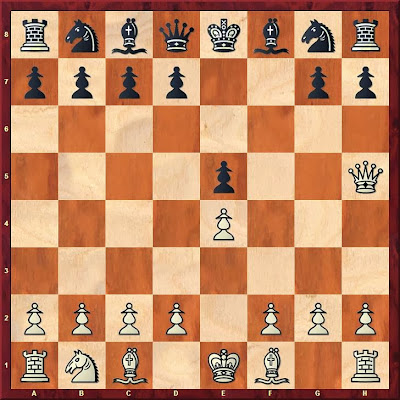1.e4 e5 2.Nf3
Black to move
Black now has a problem to solve. A pawn is under attack. How will it be defended? Alternately, Black could attack White's central pawn. Every problem in chess is an opportunity. Black's decision presents an opportunity to steer the game.
There are poor ways to defend the pawn: 2...Qf6, 2...Bd6, and 2...f6. We looked at illustrative games with each of these moves in late September and early October. Black does well defending the pawn with 2...d6 or 2...Nc6. Throughout chess history, different analysts have favored one of these moves over the other. 2...Nc6 is more popular, but 2...d6 has always had its advocates. We looked at a few ideas with these moves earlier in October.
Black may counterattack with 2...Nf6.
The move initiates the Russian Defense (also called the Petroff Defense). It was popular for a while in the nineteenth century when some players in Russia, led by Alexander Petroff, studied it in detail and began playing it in tournaments. It has become popular again in our day. One of the leading advocates was World Chess Champion in the early part of our century, Vladimir Kramnik. He is Russian, too. Analysis of the opening, however, can be found even in the oldest chess books (see "Petroff Defense: Early History").
We looked at some lines that may occur in scholastic competition.
After 2...Nf6, White should capture the pawn. Black should then drive White's knight back, then capture the pawn on e4. Young players, however, are often prone to an immediate recapture.
3.Nxe5 Nxe4
White to move
How does White exploit Black's error?
4.Qe2! is best.
White's attack on the knight must be met. Retreating the knight loses the queen to a discovered check that also attacks the queen.
First Variation
4...d5 defends the knight. White then attacks the knight with a pawn: 5.d3. It seems that the Knight should retreat, but the same problem remains. 5...Nf6 6.Nc6+ and Black's queen is lost.
Black to move
Second Variation
After the initial moves 1.e4 e5 2.Nf3 Nf6 3.Nxe5 Nxe4 4.Qe2, Black should continue meeting attack with counterattack.
4...Qe7 is best.
White to move
I have often heard young players complain, "my opponent is copying my moves." I always want to laugh because such copying is not against the rules, and it always courts peril for the second player.
5.Qxe4
Every player should see that copying with 5...Qxe5 leads to disaster. Instead, Black attacks the knight because it is pinned.
5...d6
White defends the knight, or at least the square on which it stands.
6.d4
Now, Black could capture the knight with the pawn. That is probably the best move. Instead, we looked at an illustrative game from the works of Gioachino Greco because it offers some instructive tactics.
6...f6 7.f3 Nd7
White to move
Black has four attackers on the knight. White has three defenders. No additional White pieces can be brought up to add protection. However, White has another resource.
8.Nc3!
Black will capture the knight, but White will then harass Black's queen.
8...dxe5 9.Nd5 Qd6 10.dxe5 fxe5 11.fxe5
Black to move
Black's best move here is 11...Nxe5, but after 12.Bf4 White has pinned the knight two ways and will win it. Greco offered an alternative that maintains material equality a few moves longer, but ultimately loses more than a knight.
11...Qc6 12.Bb5
Is this bishop safe from recapture?
12...Qc5 13.Be3
Now capturing the bishop on b5 is the only way to avoid immediately losing the queen.
13...Qxb5
White to move
14.Nxc7+ Kd8 15.Nxb5
The moral of this story: Black must first drive away the knight on e5, and only then capture the pawn on e4. Failure to play the correct sequence often results in the loss of a queen, giving White excellent chances of victory.



























































